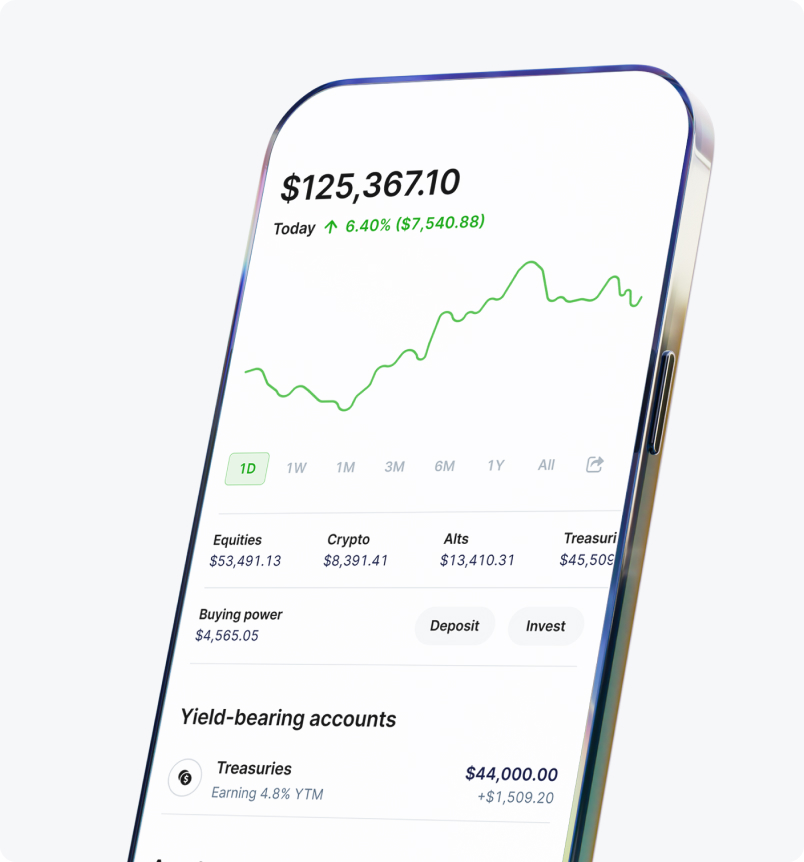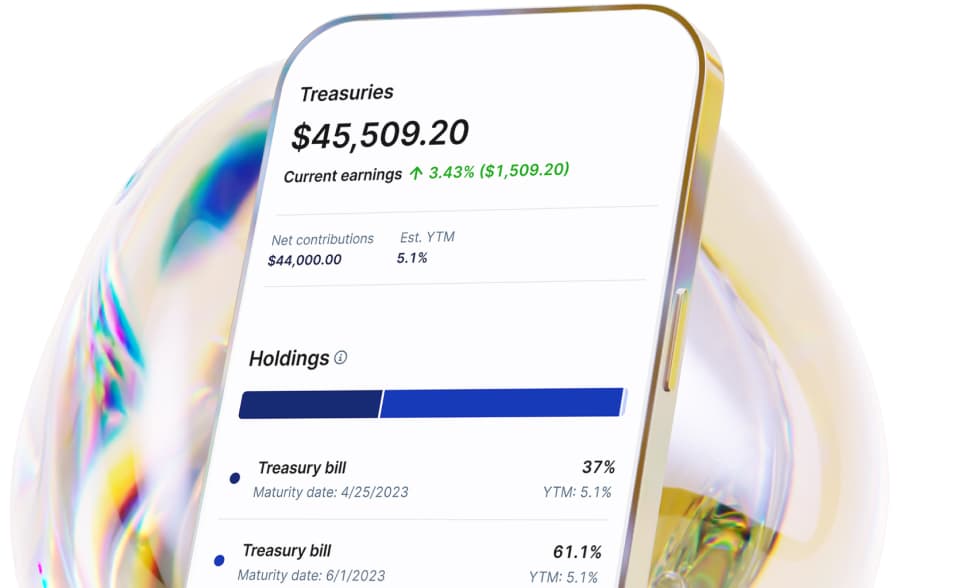© Copyright 2024 Public Holdings, Inc. All Rights Reserved.
Market data powered by Xignite.
All investments involve the risk of loss and the past performance of a security or a financial product does not guarantee future results or returns. You should consult your legal, tax, or financial advisors before making any financial decisions. This material is not intended as a recommendation, offer, or solicitation to purchase or sell securities, open a brokerage account, or engage in any investment strategy.
Product offerings and availability vary based on jurisdiction.
Stocks, ETFs, Options, Bonds.
Self-directed brokerage accounts and brokerage services for US-listed, registered securities, options, and Bonds, except for treasury securities offered through Jiko Securities, Inc., are offered to self-directed customers by Open to the Public Investing, Inc. (“Public Investing”), a registered broker-dealer and member of FINRA & SIPC. Additional information about your broker can be found by clicking here. Public Investing is a wholly-owned subsidiary of Public Holdings, Inc. (“Public Holdings”). This is not an offer, solicitation of an offer, or advice to buy or sell securities or open a brokerage account in any jurisdiction where Public Investing is not registered. Securities products offered by Public Investing are not FDIC insured. Apex Clearing Corporation, our clearing firm, has additional insurance coverage in excess of the regular SIPC limits. Additional information can be found here.
Options.
Certain requirements must be met in order to trade options. Options can be risky and are not suitable for all investors. Options transactions are often complex, and investors can rapidly lose the entire amount of their investment or more in a short period of time. Investors should consider their investment objectives and risks carefully before investing in options. Refer to the Characteristics and Risks of Standardized Options before considering any options transaction. Supporting documentation for any claims, if applicable, will be furnished upon request. Tax considerations with options transactions are unique and investors considering options should consult their tax advisor as to how taxes affect the outcome of each options strategy.
Options Order Flow Rebate.
If you are enrolled in our Options Order Flow Rebate Program, Public Investing will share 50% of our estimated order flow revenue for each completed options trade as a rebate to help reduce your trading costs. The exact rebate will depend on the specifics of each transaction and will be previewed for you prior to submitting each trade. This rebate will be deducted from your cost to place the trade and will be reflected on your trade confirmation. Order flow rebates are not available for non-options transactions. To learn more, see our Fee Schedule, Order Flow Rebate FAQ, and Order Flow Rebate Program Terms & Conditions.
Bonds.
“Bonds” shall refer to corporate debt securities and U.S. government securities offered on the Public platform through a self-directed brokerage account held at Public Investing and custodied at Apex Clearing. For purposes of this section, Bonds exclude treasury securities held in treasury accounts with Jiko Securities, Inc. as explained under the “ Treasury Accounts” section.
Investments in Bonds are subject to various risks including risks related to interest rates, credit quality, market valuations, liquidity, prepayments, early redemption, corporate events, tax ramifications and other factors. The value of Bonds fluctuate and any investments sold prior to maturity may result in gain or loss of principal. In general, when interest rates go up, Bond prices typically drop, and vice versa. Bonds with higher yields or offered by issuers with lower credit ratings generally carry a higher degree of risk. All fixed income securities are subject to price change and availability, and yield is subject to change. Bond ratings, if provided, are third party opinions on the overall bond's credit worthiness at the time the rating is assigned. Ratings are not recommendations to purchase, hold, or sell securities, and they do not address the market value of securities or their suitability for investment purposes.
High-Yield Cash Account.
A High-Yield Cash Account is a secondary brokerage account with Public Investing. Funds in your High-Yield Cash Account are automatically deposited into partner banks (“Partner Banks”), where that cash earns interest and is eligible for FDIC insurance. See here for a list of current Partner Banks. Your Annual Percentage Yield is variable and may change at the discretion of the Partner Banks or Public Investing. Apex Clearing and Public Investing receive administrative fees for operating this program, which reduce the amount of interest paid on swept cash. Neither Public Investing nor any of its affiliates is a bank. Learn more.
Alternative Assets.
Brokerage services for alternative assets available on Public are offered by Dalmore Group, LLC (“Dalmore”), member of FINRA & SIPC. “Alternative assets,” as the term is used at Public, are equity securities that have been issued pursuant to Regulation A of the Securities Act of 1933 (as amended) (“Regulation A”). This content is not investment advice. These investments are speculative, involve substantial risks (including illiquidity and loss of principal), and are not FDIC or SIPC insured. Alternative Assets purchased on the Public platform are not held in a Public Investing brokerage account and are self-custodied by the purchaser. The issuers of these securities may be an affiliate of Public Investing, and Public Investing (or an affiliate) may earn fees when you purchase or sell Alternative Assets. For more information on risks and conflicts of interest, see these disclosures. An affiliate of Public may be “testing the waters” and considering making an offering of securities under Tier 2 of Regulation A. No money or other consideration is being solicited and, if sent in response, will not be accepted. No offer to buy securities can be accepted, and no part of the purchase price can be received, until an offering statement filed with the SEC has been qualified by the SEC. Any such offer may be withdrawn or revoked, without obligation or commitment of any kind, at any time before notice of acceptance given after the date of qualification by the SEC or as stated in the offering materials relating to an investment opportunity, as applicable. An indication of interest to purchase securities involves no obligation or commitment of any kind.
Cryptocurrency.
Cryptocurrency trading, execution, and custody services are provided by Bakkt Crypto Solutions, LLC (NMLS ID 1828849) (“Bakkt”). Cryptocurrency is highly speculative, involves a high degree of risk, and has the potential for loss of the entire amount of an investment. Cryptocurrencies offered by Bakkt are not securities and are not FDIC insured or protected by SIPC. Your cryptocurrency assets are held in your Bakkt account. Bakkt is a licensed virtual currency business by the New York State Department of Financial Services and a licensed money transmitter, but is not a registered broker-dealer or a FINRA member. Your Bakkt Crypto account is separate from your brokerage account with Public Investing, which holds US-listed stocks and ETFs. Please review the Risk Disclosures before trading.
Treasury Accounts.
Investing services in treasury accounts offering 6 month US Treasury Bills on the Public platform are through Jiko Securities, Inc. (“JSI”), a registered broker-dealer and member of FINRA & SIPC. See JSI’s FINRA BrokerCheck and Form CRS for further information.
JSI uses funds from your Treasury Account to purchase T-bills in increments of $100 “par value” (the T-bill’s value at maturity). T-bills are purchased at a discount to the par value and the T-bill’s yield represents the difference in price between the “par value” and the “discount price.” Aggregate funds in your Treasury Account in excess of the T-bill purchases will remain in your Treasury Account as cash. The value of T-bills fluctuate and investors may receive more or less than their original investments if sold prior to maturity. T-bills are subject to price change and availability - yield is subject to change. Past performance is not indicative of future performance. Investments in T-bills involve a variety of risks, including credit risk, interest rate risk, and liquidity risk. As a general rule, the price of a T-bills moves inversely to changes in interest rates. Although T-bills are considered safer than many other financial instruments, you could lose all or a part of your investment. See Jiko U.S. Treasuries Risk Disclosures for further details.
Investments in T-bills: Not FDIC Insured; No Bank Guarantee; May Lose Value.
Banking services and bank accounts are offered by Jiko Bank, a division of Mid-Central National Bank.
JSI and Jiko Bank are not affiliated with Public Holdings, Inc. (“Public”) or any of its subsidiaries. None of these entities provide legal, tax, or accounting advice. You should consult your legal, tax, or financial advisors before making any financial decisions. This material is not intended as a recommendation, offer, or solicitation to purchase or sell securities, open a brokerage account, or engage in any investment strategy.
Commission-free trading refers to $0 commissions charged on trades of US listed registered securities placed during the US Markets Regular Trading Hours in self-directed brokerage accounts offered by Public Investing. Keep in mind that other fees such as regulatory fees, Premium subscription fees, commissions on trades during extended trading hours, wire transfer fees, and paper statement fees may apply to your brokerage account. Please see Public’s Investing’s Fee Schedule to learn more.
Fractional shares are illiquid outside of Public and not transferable. For a complete explanation of conditions, restrictions and limitations associated with fractional shares, see our Fractional Share Disclosure to learn more.
Investment Plans. US members only. Investment Plans (“Plans”) shown in our marketplace are for informational purposes only and are meant as helpful starting points as you discover, research and create a Plan that meets your specific investing needs. Plans are self-directed purchases of individually-selected assets, which may include stocks, ETFs and cryptocurrency. Plans are not recommendations of a Plan overall or its individual holdings or default allocations. Plans are created using defined, objective criteria based on generally accepted investment theory; they are not based on your needs or risk profile. You are responsible for establishing and maintaining allocations among assets within your Plan. Plans involve continuous investments, regardless of market conditions. Diversification does not eliminate risk. See our Investment Plans Terms and Conditions and Sponsored Content and Conflicts of Interest Disclosure.
Market Data. Quotes and other market data for Public’s product offerings are obtained from third party sources believed to be reliable, but Public makes no representation or warranty regarding the quality, accuracy, timeliness, and/or completeness of this information. Such information is time sensitive and subject to change based on market conditions and other factors. You assume full responsibility for any trading decisions you make based upon the market data provided, and Public is not liable for any loss caused directly or indirectly by your use of such information. Market data is provided solely for informational and/or educational purposes only. It is not intended as a recommendation and does not represent a solicitation or an offer to buy or sell any particular security.


